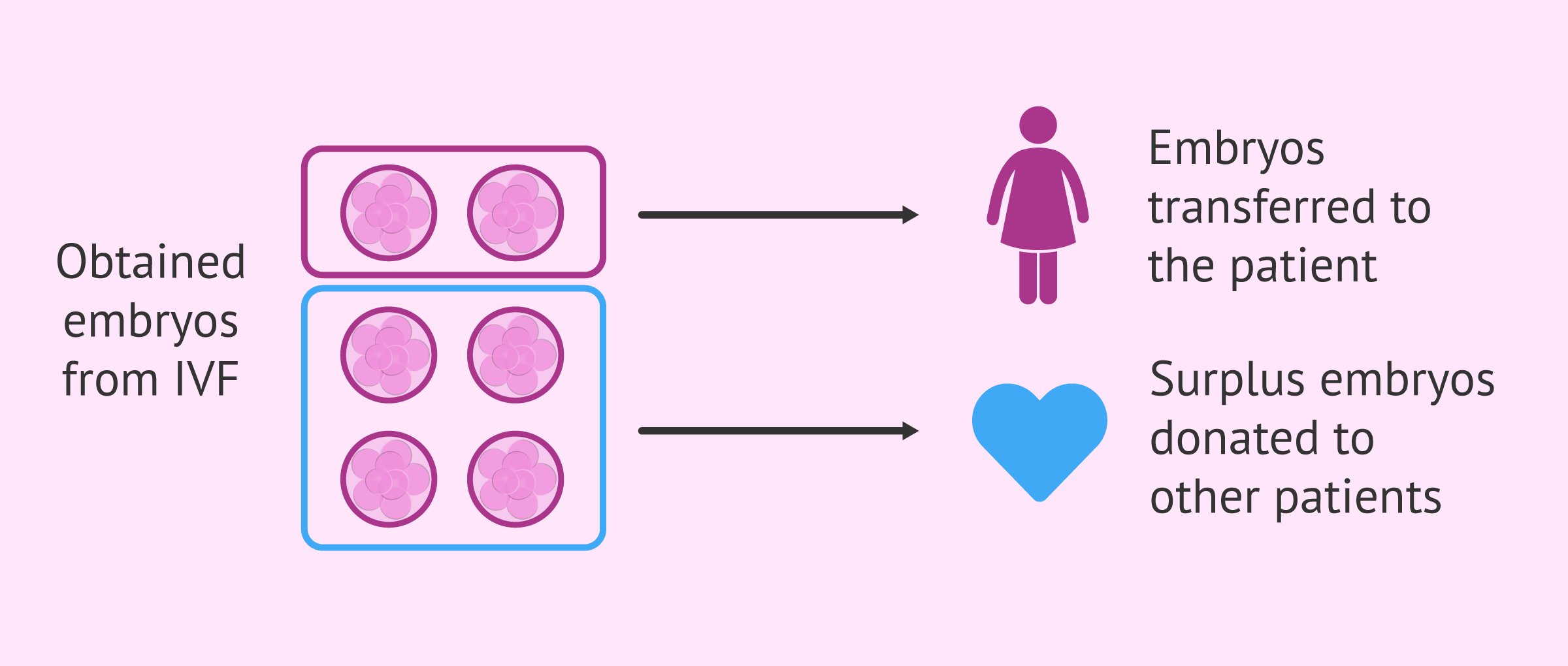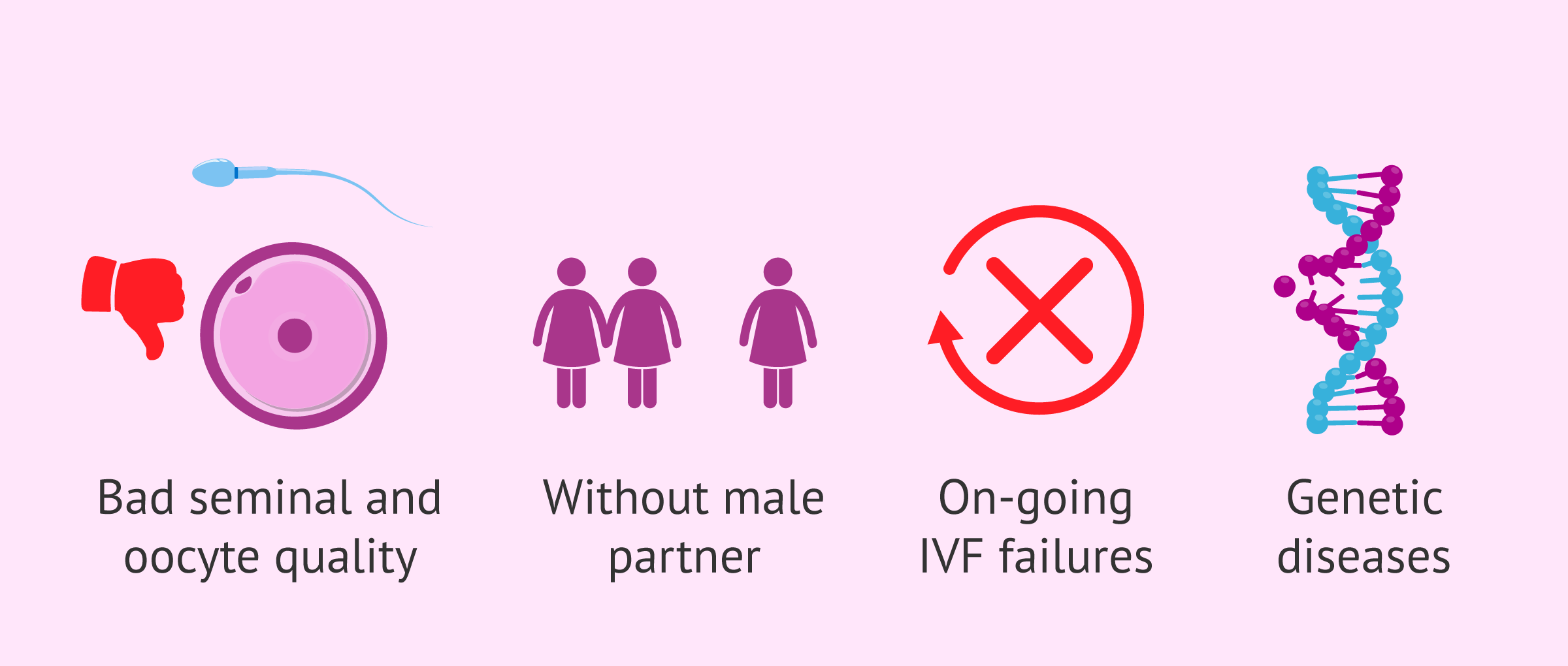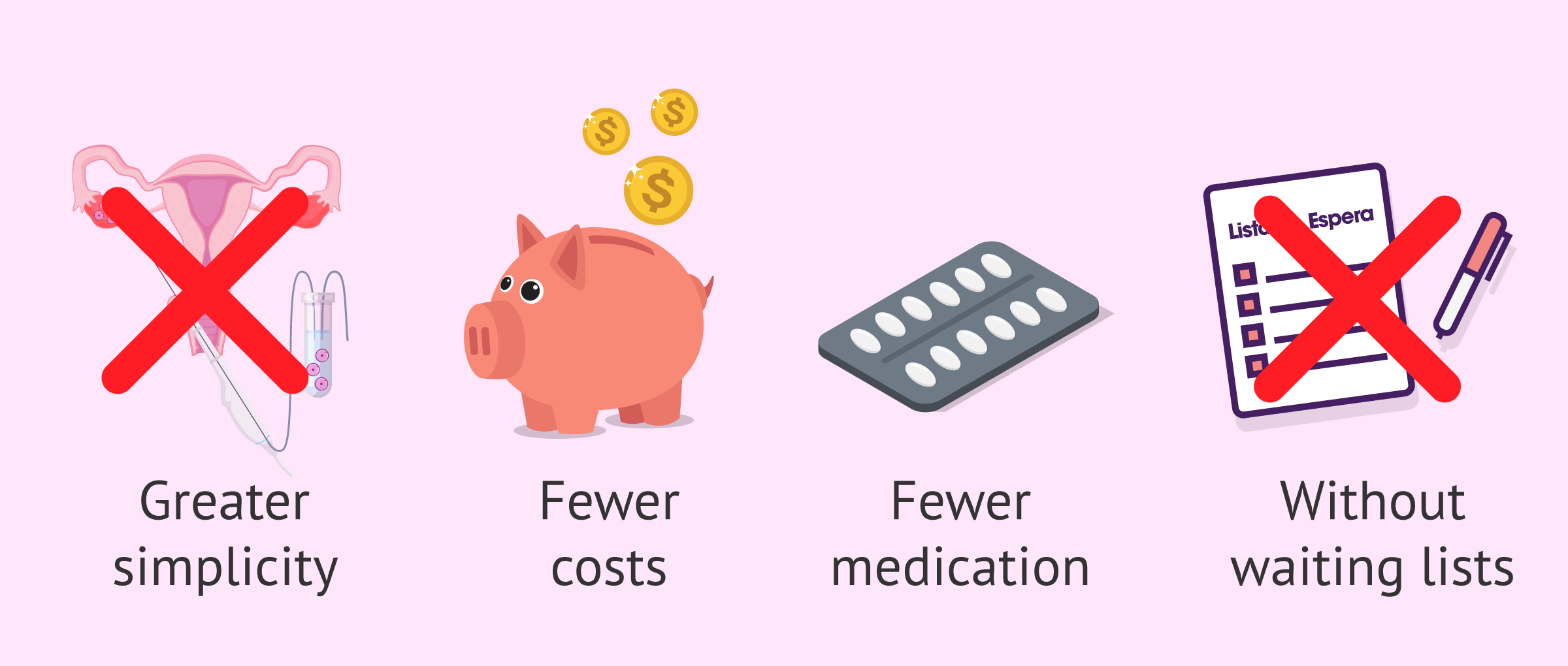Embryo adoption is a reproductive treatment by which a couple tries to become pregnant by transferring the embryos left over from the in vitro fertilization (IVF) treatment of another couple, who have decided to donate them anonymously and altruistically.
For this reason, this technique is also known as embryo donation, as one couple donates the embryos and another adopts them. In this way, we can speak of two terms:
- Embryo donation, from the point of view of the person or couple, donating their surplus embryos to help other couples.
- Embryo adoption, from the point of view of the person or couple receiving embryos from other patients with the aim of achieving pregnancy.
Provided below is an index with the 10 points we are going to expand on in this article.
- 1.
- 1.1.
- 2.
- 3.
- 4.
- 5.
- 6.
- 7.
- 7.1.
- 7.2.
- 7.3.
- 7.4.
- 7.5.
- 7.6.
- 7.7.
- 7.8.
- 7.9.
- 8.
- 9.
- 10.
What is embryo donation?
Embryo donation, embryo adoption is an assisted reproduction technique that consists of the transfer of embryos from one woman or couple to the uterus of another recipient woman. Therefore, the embryos that are transferred to the recipient woman carry the genetic load of other people.
This reproductive technique carries a great emotional burden since it implies the renunciation of genetic material. However, it is a simpler and less expensive technique than other assisted reproduction treatments.
When is embryo adoption recommended?
The adoption of embryos is a reproductive alternative that is recommended in those cases where it is not possible to achieve pregnancy using one's own gametes. Normally, the most common situations are the following:
- Both members of the couple with fertility problems, either due to poor egg quality or low seminal quality.
- Women with fertility problems without male partner.
- Previous failures in IVF cycles with own eggs.
- Repeat miscarriages.
- Possible transmission of genetic diseases.
Therefore, embryo adoption and double gamete (egg and sperm) donation are the options available to those women or couples with infertility problems who have difficulties in achieving a pregnancy.
Embryos left over from IVF treatment
When a couple undergoes in vitro fertilization (IVF) treatment, the woman receives a hormonal treatment aimed at promoting ovarian production. In this way, the greatest number of eggs is obtained, thus increasing the chances of pregnancy.
From all the embryos obtained, the ones with the highest quality will be selected for transfer to the future mother's uterus, with the hope that pregnancy will be achieved.
It is common to transfer between 1 and 2 embryos, although the law allows the transfer of up to a maximum of 3 embryos. The rest of the embryos that present good quality, the so-called leftover embryos, will be cryopreserved through the freezing process known as vitrification.
The couple must choose what to do with the cryopreserved embryos left over from their treatment:
- Cryopreservation for own treatments in the future.
- Donation for reproductive purposes, this means that the surplus embryos can be donated for fertility treatments of other couples.
- Embryo donation for research.
- Destruction. This option can be carried out when the woman's reproductive life has ended.
Generally, patients' first decision is to cryopreserve them for future transfers. However, when the couple decides that they do not wish for more children, the option of donating the frozen embryos to others who wish to have children is an alternative.
It must be taken into account that patients will have to renew the informed consent for cryopreservation of embryos every two years, as well as pay for their maintenance according to the conditions of each assisted reproduction center.
Dr. Miguel Dolz comments that in order to donate embryos for reproductive purposes, the woman's egg has to be under 35 years old and free of pathologies, etc.
Advantages of adopting embryos
Embryo donation for reproductive purposes is an assisted reproduction treatment to which more and more patients are turning to.
For a couple experiencing problems with conception, and after several failed attempts of other assisted reproduction techniques such as artificial insemination (AI) or in vitro fertilization (IVF), the possibility of adopting embryos is a great option due to its numerous advantages. Some of them are listed below:
- No waiting list: access to treatment is quite direct, although it is necessary that the embryo shares a number of characteristics with the future parents: blood type, HR, phenotype features…
- Endometrium preparation: the woman does not need ovarian stimulation as in the case of IVF. It is simply necessary to prepare the endometrium to encourage the implantation of the transferred embryos. Medication (estrogen and progesterone) is administered simply: patches, oral medication, or vaginal tablets. The evolution of the endometrium is controlled by ultrasound.
- Consultations: the preparation of the endometrium is simpler than ovarian stimulation for IVF. Also, fewer visits are necessary.
- Costs: Embryo adoption costs less than IVF with your own eggs and much less than IVF with double gamete donation. Furthermore, the amount of medication is also reduced, which also means a reduction in the price of this reproductive technique.
- Time: in the same year the patient can perform the entire treatment and have her baby. Once the transfer is programmed, depending on the state of the recipient's endometrium, the devitrification of the embryos and the transfer of the same is carried out in one day and after two weeks of waiting, the woman takes a pregnancy test.
It is important to note that embryo donation, like gamete donation, is anonymous , so prospective parents will not know the origin of the adopted embryos.
Success rates
The success rate of adoption treatment of embryos donated by another couple depends largely on the quality of the embryos. In this case, the characteristics of the recipient woman are not the most important, although they do have an influence.
The thawing of the embryos has very good survival rates since vitrification allows the recovery of the embryos in approximately 90% of the cases. Nevertheless, it is important to highlight that the embryos used when choosing this assisted reproduction treatment come from couples with fertility problems and, therefore, the probability of pregnancy is not very high.
Specifically, according to the latest statistical data compiled by the Spanish Fertility Society for the year 2022 about embryo donation:
- The gestation rate per embryo transfer is 44.2%.
- The rate of delivery by embryo transfer is 31.9%.
Furthermore, it must be taken into account the possibility that the adopted embryos come from patients who have used eggs and/or sperm from donors for their IVF treatment. In this case, the quality of the embryos will be higher and therefore the probability of gestation may be increased.
Finally, before agreeing to undergo this type of reproductive treatment, the couple must be sure that they do not mind that the future baby does not have their genes, as well as understand all the bioethical and moral aspects that this process may entail.
Costs of embryo donation
As we have mentioned, embryo donation is an option to reduce the cost of assisted reproduction treatment.
The average price of embryo adoption ranges from $2,500 to $4000, depending on factors such as the fertility clinic, the tests needed for the process, the situation of each patient, or couple, etc.
Hormonal medication for endometrial preparation is not normally included in the total cost of treatment.
In case you wish to undergo IVF with donated embryos to have a baby, we recommend that you get your Fertility Report now. This tool can offer you in real time a list of recommended clinics that meet our rigorous selection criteria, and we consider top fertility centers for our readers. The report you will receive will inform you about the prices and conditions that each clinic offers for embryo adoption.
Video on embryoadoption
Michelle Emblenton, biochemist at inviTRA, talks in this video about embryo donation or embryo adoption, its indications, advantages, success rate and price.
FAQs from users
With an embryo donation, can I have problems of incompatibility or rejection of these embryos?
Rearkably, a woman’s uterus does not reject an embryo, even though it is half “foreign” due to fertilization by the mans’ sperm. More fascinating, the uterus accepts an embryo from a double-donation of egg and sperm. There are theories to explain why a woman’s uterus does not reject the embryo as foreign but no definitive reason has emerged.
Is body mass index a requirement for embryo adoption treatment?
No, it is always convenient to have a normal BMI but it is not a requirement to be able or not to receive donated embryos.
The BMI is a mathematical formula that associates the mass and height of an individual, it is calculated by dividing the weight, always expressed in Kg, by the height, expressed in meters squared.
The patient should know that if she has a normal BMI (18.5-24.9) she has a better chance of pregnancy; while if she has a BMI that is too high or too low she will decrease her chances of pregnancy. However, patients with BMIs outside the normal range do achieve full-term pregnancies.
Are the physical characteristics of both couples taken into account when the matching for embryo adoption is done?
Yes, both in cases of gamete donation (eggs and sperm) and embryo donation, the medical team tries to match the physical characteristics of the donor with those of the recipient (e.g. blood type).
Is it possible to adopt embryos in natural cycle?
Yes, it can be done but it is not common. Usually the woman receives hormonal treatment to promote endometrial growth and thus increase the likelihood of implantation and therefore pregnancy.
Is embryo adoption a valid choice for pro-life Catholics?
The pro-life side of the Catholic Church is in favor of what they refer to as prenatal adoption, that is, adopting another couple's unused embryos from IVF.
Each year, over 600,000 embryos are thrown away only in the United States, so embryo adoption is a very valid option for Catholic families who suffer from infertility and wish to build their family through an alternative method.
In this sense, there exist various associations such as "Snowflakes Embryo Adoption and Donation", created by Nightlight Christian Adoptions, which pioneered embryo adoption in 1997. More than 480 babies have been born ever since.
For more information, please visit the following post: Religious views on gamete donation and embryo adoption.
Does embryo adoption qualify for tax credit?
In the United States, embryo donation is not considered an adoption, but rather a property transfer by state laws. Taking this into account, those who adopt an embryo are not eligible for an adoption credit. However, the state of Georgia has enacted an statute called "Option of Adoption Act", which has made some couples eligible for Federal Adoption Tax Credit.
Are there embryo donation databases to assist in matching donated embryos to patients?
Yes, there are donor embryo banks that allow you to search for embryos which characteristics resemble yours. Some even post pictures of the biological parents, while others are more private.
Online donor embryo banks assist in matching donated embryos to patients with whom they share a similar profile.
Donor embryo vs. donor egg, what is better?
No technique is better than the other; it just depends on the characteristics of each patient and what is causing infertility.
For instance, in cases where the male partner produces good-quality sperm, egg donation would be the most advisable treatment, as this allows for at least one of the intended parents to share his DNA with future offspring.
However, if both partners are infertile, double-donor IVF or embryo adoption would be the options of choice. In the former, the eggs and the sperms are of an excellent quality, as they both have been created using donor gametes. As for the latter, it involves using the spare embryos from the IVF cycle of another couple; although it is more affordable from the financial point of view, its success depends on the quality of the adopted embryos. Conversely, outcomes obtained by donation are usually satisfactory, but are dependent on the uterine conditions of the recipient.
As can be seen, several factors have an influence on such decision, so examining each case individually to determine what may be the most suitable option according to medical, economical and psychological aspects is crucial.
Are there options for an open embryo donation?
Yes, open embryo donation is allowed in some countries. In that case, it works more similarly to traditional adoption of a live child. It is a more expensive process and requires a greater level of participation, though.
Given that an open embryo donation agreement is required, participants are required to seek legal representation.
Recommended reading
If you are interested in learning more about double gamete donation, we recommend you to visit this link: Double donor IVF: assisted reproduction with donor egg and sperm.
On the other hand, if you want to know more about the possible destinations of surplus embryos in IVF, you can read the following article: What happens to the excess unused embryos after an IVF treatment?
We make a great effort to provide you with the highest quality information.
🙏 Please share this article if you liked it. 💜💜 You help us continue!
References
Comisión Nacional de Reproducción Humana Asistida (CNRHA) (2015). Aspectos legales y éticos de la donación. En: Registro Nacional de Donantes de Gametos y Preembriones. Ministerio de Sanidad, Consumo y Bienestar Social de España (View)
Ley 14/2006, de 26 de mayo, sobre técnicas de reproducción humana asistida. Jefatura del Estado «BOE» núm. 126, de 27 de mayo de 2006 Referencia: BOE-A-2006-9292 (View)
Manuel Muñoz y María Nicolás. Donación de embriones con fines reproductivos. Manual de Buena Práctica Clínica en Reproducción Asistida (pp. 75-88). Sociedad Española de la Fertilidad (View)
Sociedad Española de Fertilidad (SEF) (febrero de 2012). “Saber más sobre fertilidad y reproducción asistida”. En colaboración con el Ministerio de Sanidad, Política Social e Igualdad del Gobierno de España y el Plan de Calidad para el Sistema Nacional de Salud.
Sociedad Española de la Fertilidad (SEF). Libro Blanco Sociosanitario. La Infertilidad en España Situación Actual y Perspectivas. Imago Concept & Image Development 2011.
Sociedad Española de Fertilidad. Registro Nacional de Actividad 2022-Registro SEF. (View)
FAQs from users: 'For embryo adoption, where do embryos come from?', 'With an embryo donation, can I have problems of incompatibility or rejection of these embryos?', 'Is body mass index a requirement for embryo adoption treatment?', 'Are there any risks of incompatibility or rejection when using donated embryos?', '¿Is embryo donation anonymous or open?', '¿Is it possible to do embryo adoption in a natural cycle?', 'How much does embryo adoption cost?', 'What is the success rate of embryo adoption?', 'Are the physical characteristics of both couples taken into account when the matching for embryo adoption is done?', 'Is it possible to adopt embryos in natural cycle?', 'What are the advantages of embryo adoption?', 'Is embryo adoption a valid choice for pro-life Catholics?', 'What is the fate of leftover embryos after IVF treatment?', 'When is embryo adoption recommended?', 'Does embryo adoption qualify for tax credit?', 'Are there embryo donation databases to assist in matching donated embryos to patients?', 'What is embryo donation and adoption?', 'Donor embryo vs. donor egg, what is better?', 'Should surplus IVF embryos be donated to stem cell research?' and 'Are there options for an open embryo donation?'.
Authors and contributors



More information about Michelle Lorraine Embleton











Hi,
I got poor results after a genetic study of the embryo. Is the next step for me to use donor eggs or embryo adoption?
Hi Lindsey3005
If all your embryos are genetically altered, it would be necessary to determine the possible cause before making a decision. In some cases it is necessary to resort to IVF with donor eggs, IVF with double donation or even another alternative would be the adoption of embryos, which would be the simplest and most economical technique. My recommendation is that you evaluate it with your doctor, who knows your case perfectly, and ask him any questions you may have.
I hope I have helped you.
Best wishes
Hello there,
I’ve understood everything you’ve mentioned here, but I’ve a question: what happens to embryos that don’t implant? I’m in the middle of my IVF treatment and I’d like to find out the answer to this question, because maybe we donate our embryos, but we haven’t made up our minds yet.
Thanks!
Hello Olivia,
The embryos that do not implant are expelled by your own body; they are so small that you don’t even realize. In some cases, this process is accompanied by some spotting or light bleeding, but it is unnoticeable.
Hope this clears your doubts 😉